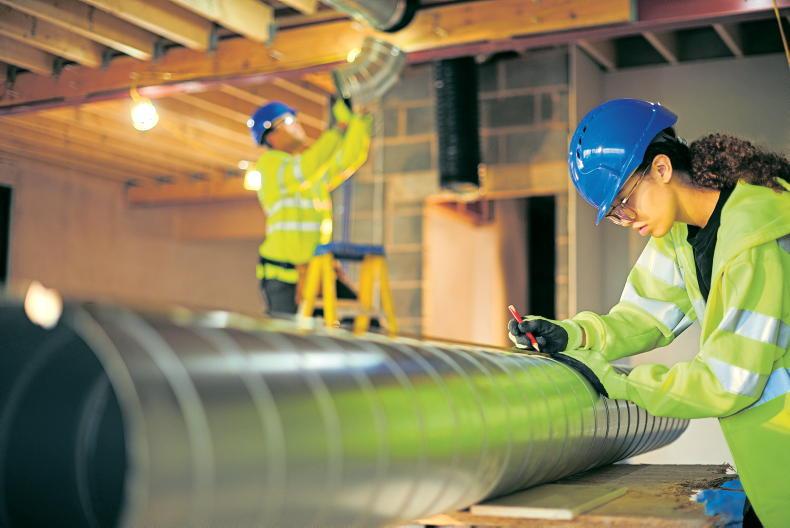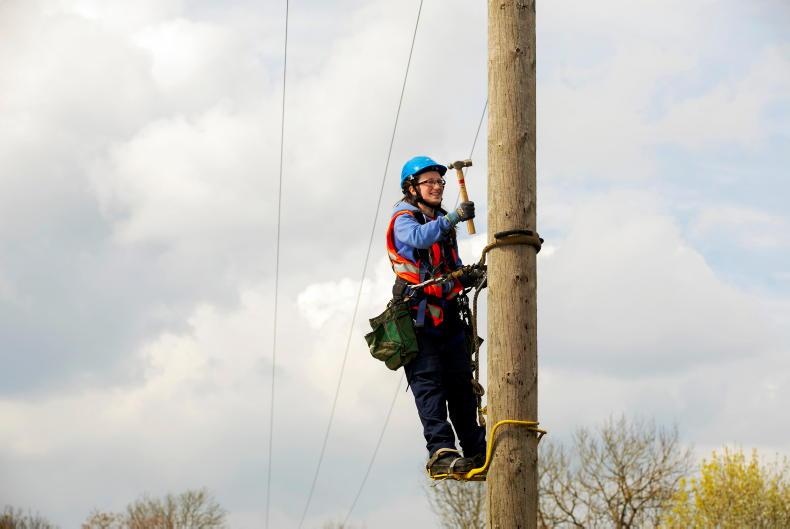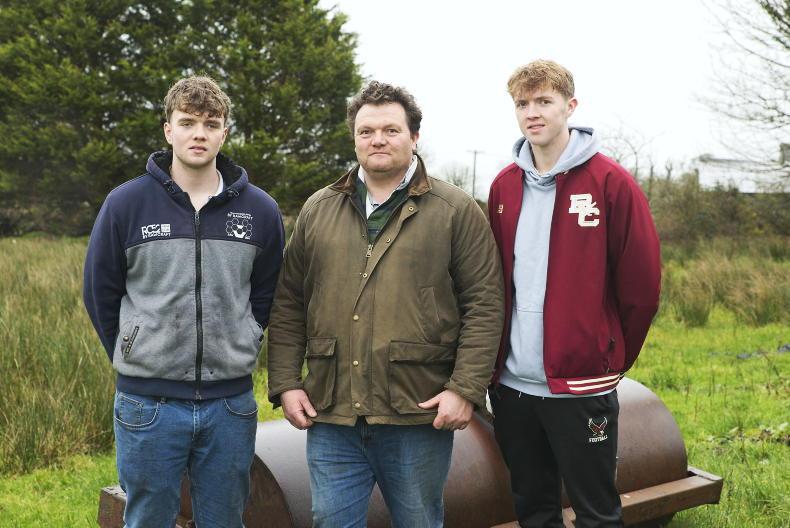With a labour shortage in the construction and trade industry, frustration has been felt by apprentices as 9,000 people are waiting for off-the-job training, of which 3,600 are waiting longer than six months.
As a result, a ready and eager to learn workforce are being deterred due to the prolonged uncertainty of when and where there training will take place.
Reasons for the delays
The high levels of registrations for the electrical, plumbing, and carpentry and joinery programmes means these are the most impacted. Other programmes including pipefitting and wood manufacturing have also been affected by the backlog.
In addition to the increased demand, the main reason for the delays, according to the National Apprenticeship Office is the impact of COVID-19. The pandemic resulted in the closure of training facilities for an extended period and reduced capacity in workshops.

Mairéad Farrell, TD Galway West constituency.
Impact on workforce
Mairéad Farrell, Galway West TD was immediately contacted in relation to the wait times when she took over as spokesperson on further and higher education in April last year.
“I had an apprentice get onto me saying that they had been waiting for a considerable length of time. They were in a position whereby they went back to the trade to try and upskill. It was impacting them in terms of being able to afford to live. At the time, he and his wife were in complete despair; one was living in Kilkenny, the other in Dublin, he was waiting 21 months before getting off-the-job training,” she says.
Mairead has put in numerous parliamentary questions to the Oireachtas on this matter and received an outpouring across social media from apprentices in sheer frustration.
“The latest that I have is there are 9,000 waiting for off-the-job training. These are people who want to build the homes that we need. We’re constantly being told that the reason we can’t build these houses is because of a shortage of labour. We should have an efficient system to enable people to get their off-the-job training. Get them out there and get the work done,” she says.
This is also resulting in apprentices being locked in the lower pay bracket until they are qualified, which in a cost-of-living crisis is having a significant impact on their financial security.
A spokesperson for the National Apprenticeship Office told Irish Country Living “SOLAS and the National Apprenticeship Office is acutely aware of the impact of these delays on apprentices, their families, and employers. Significant efforts have and continue to be made to increase training capacity including capital investment and recruitment of additional apprentice instructors.”
Emergency plan
An emergency plan is currently being implemented, coordinated by the National Apprenticeship Office in close partnership with SOLAS, the Higher Education Authority and training providers across further and higher education.
The goal of this plan is to eliminate training delays in 2024 with increased capital investment and the recruitment of additional craft apprenticeship instructors enabling the delivery of double the number of phase 2 training places.
“The plan is already having an impact with the backlog reducing over the last three months. We will continue to closely monitor this and work to ensure that apprentices can gain access to their off-the-job training in as timely a fashion as possible,” says the spokesperson.
Committed to maintaining progress
A spokesperson from the Department of Education responded to Irish Country Living on their plan to reduce the ‘backlog’.
“This Department has been unrelenting in its focus to secure sustained reductions in waiting times for apprenticeship training.
“There has been a significant reduction in apprentices waiting longer than six months for their off-the-job training, considered the ‘backlog’. The backlog stood at some 3,600 in February 2024, down from over 5,200 in in August 2023.
“As part of this, increased funding of €67 million allocated to apprenticeships, bringing the total investment to almost €300 million in 2024, is a vital step in building the capacity required to both reduce delays in apprenticeship training and meet future training requirements.”
Training locations
Apprenticeship training is delivered in multiple locations nationwide. It works on the basis of a national waiting list for apprentices on all programmes, with those at the top of the list being allocated the next available training location when it becomes available, regardless of where an apprentice is living.
“If the system offered a more regional approach, apprentices living in more rural locations may only have access to one location, whereas those in urban areas may have five or six locations to be allocated to, resulting in an unfair advantage to these apprentices. The method of allocating training places has been done in such a way as to ensure that apprentices have equal access to training opportunities regardless of whether they are living in a rural or urban area,” says the spokesperson.
Where apprentices do have to travel for their off-the-job training, an accommodation allowance is paid to support them, along with associated costs.
The number of new apprentice registrations is at its highest level with more people registering to become an apprentice than ever before. In 2024, there were 8,712 new registrations and the live population of apprentices at the end of January 2024 stood at 27,407 across 73 apprenticeship programmes.
Keith Murry, electrical epprentice

Keith Murry.
“I’m an electrical apprentice in third year working with CJK Engineering. I am currently waiting for phase four which is college learning.
I started my apprenticeship in May 2021. Even before I got registered for SOLAS to get my name in for college, I was told there was a backlog due to COVID-19. There was a waiting list of 12-18 months for phase two which is the first college phase, instead of a six month wait. This didn’t affect me as I was still living at home, but my other colleagues were because some of them had rent and kids to look after and it was holding them back from getting qualified.
In the end, it actually took 22 months before I got called for my phase two which was in Thurles. At first, I didn't want to be going down the country for the summer but as weeks went on, I made new mates. Living away from home , I had to learn how to cook and clean for myself.
My company CJK were very helpful. Most companies don’t have to pay the standard rate unless you’ve completed a certain phase in college but because the backlog was so bad, they still went ahead with paying the rates.”
Read more
ESB Networks seeking electrical apprentices
AgTech, an emerging sector for employment
With a labour shortage in the construction and trade industry, frustration has been felt by apprentices as 9,000 people are waiting for off-the-job training, of which 3,600 are waiting longer than six months.
As a result, a ready and eager to learn workforce are being deterred due to the prolonged uncertainty of when and where there training will take place.
Reasons for the delays
The high levels of registrations for the electrical, plumbing, and carpentry and joinery programmes means these are the most impacted. Other programmes including pipefitting and wood manufacturing have also been affected by the backlog.
In addition to the increased demand, the main reason for the delays, according to the National Apprenticeship Office is the impact of COVID-19. The pandemic resulted in the closure of training facilities for an extended period and reduced capacity in workshops.

Mairéad Farrell, TD Galway West constituency.
Impact on workforce
Mairéad Farrell, Galway West TD was immediately contacted in relation to the wait times when she took over as spokesperson on further and higher education in April last year.
“I had an apprentice get onto me saying that they had been waiting for a considerable length of time. They were in a position whereby they went back to the trade to try and upskill. It was impacting them in terms of being able to afford to live. At the time, he and his wife were in complete despair; one was living in Kilkenny, the other in Dublin, he was waiting 21 months before getting off-the-job training,” she says.
Mairead has put in numerous parliamentary questions to the Oireachtas on this matter and received an outpouring across social media from apprentices in sheer frustration.
“The latest that I have is there are 9,000 waiting for off-the-job training. These are people who want to build the homes that we need. We’re constantly being told that the reason we can’t build these houses is because of a shortage of labour. We should have an efficient system to enable people to get their off-the-job training. Get them out there and get the work done,” she says.
This is also resulting in apprentices being locked in the lower pay bracket until they are qualified, which in a cost-of-living crisis is having a significant impact on their financial security.
A spokesperson for the National Apprenticeship Office told Irish Country Living “SOLAS and the National Apprenticeship Office is acutely aware of the impact of these delays on apprentices, their families, and employers. Significant efforts have and continue to be made to increase training capacity including capital investment and recruitment of additional apprentice instructors.”
Emergency plan
An emergency plan is currently being implemented, coordinated by the National Apprenticeship Office in close partnership with SOLAS, the Higher Education Authority and training providers across further and higher education.
The goal of this plan is to eliminate training delays in 2024 with increased capital investment and the recruitment of additional craft apprenticeship instructors enabling the delivery of double the number of phase 2 training places.
“The plan is already having an impact with the backlog reducing over the last three months. We will continue to closely monitor this and work to ensure that apprentices can gain access to their off-the-job training in as timely a fashion as possible,” says the spokesperson.
Committed to maintaining progress
A spokesperson from the Department of Education responded to Irish Country Living on their plan to reduce the ‘backlog’.
“This Department has been unrelenting in its focus to secure sustained reductions in waiting times for apprenticeship training.
“There has been a significant reduction in apprentices waiting longer than six months for their off-the-job training, considered the ‘backlog’. The backlog stood at some 3,600 in February 2024, down from over 5,200 in in August 2023.
“As part of this, increased funding of €67 million allocated to apprenticeships, bringing the total investment to almost €300 million in 2024, is a vital step in building the capacity required to both reduce delays in apprenticeship training and meet future training requirements.”
Training locations
Apprenticeship training is delivered in multiple locations nationwide. It works on the basis of a national waiting list for apprentices on all programmes, with those at the top of the list being allocated the next available training location when it becomes available, regardless of where an apprentice is living.
“If the system offered a more regional approach, apprentices living in more rural locations may only have access to one location, whereas those in urban areas may have five or six locations to be allocated to, resulting in an unfair advantage to these apprentices. The method of allocating training places has been done in such a way as to ensure that apprentices have equal access to training opportunities regardless of whether they are living in a rural or urban area,” says the spokesperson.
Where apprentices do have to travel for their off-the-job training, an accommodation allowance is paid to support them, along with associated costs.
The number of new apprentice registrations is at its highest level with more people registering to become an apprentice than ever before. In 2024, there were 8,712 new registrations and the live population of apprentices at the end of January 2024 stood at 27,407 across 73 apprenticeship programmes.
Keith Murry, electrical epprentice

Keith Murry.
“I’m an electrical apprentice in third year working with CJK Engineering. I am currently waiting for phase four which is college learning.
I started my apprenticeship in May 2021. Even before I got registered for SOLAS to get my name in for college, I was told there was a backlog due to COVID-19. There was a waiting list of 12-18 months for phase two which is the first college phase, instead of a six month wait. This didn’t affect me as I was still living at home, but my other colleagues were because some of them had rent and kids to look after and it was holding them back from getting qualified.
In the end, it actually took 22 months before I got called for my phase two which was in Thurles. At first, I didn't want to be going down the country for the summer but as weeks went on, I made new mates. Living away from home , I had to learn how to cook and clean for myself.
My company CJK were very helpful. Most companies don’t have to pay the standard rate unless you’ve completed a certain phase in college but because the backlog was so bad, they still went ahead with paying the rates.”
Read more
ESB Networks seeking electrical apprentices
AgTech, an emerging sector for employment











SHARING OPTIONS